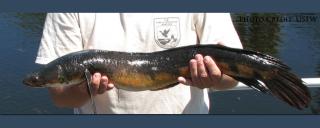
Bullseye Snakehead
| Scientific Name | (Channa marulius) |
|---|---|
| Classification and Permitting Level | 1 - Prohibited Aquatic Nuisance Species |
| Species Description | Bullseye snakehead is an invasive fish that can be distinguished from native burbot or bowfin and other invasive snakehead fish by the distinctive orange spot near the tail. It grows to about 47 inches in the US and has a dark brown coloration above and orange coloration below. |
| Preferred Habitat | It can be found in many habitats, including deep clear lakes and rivers with rocky to sandy substrate or in vegetated areas of swamps, slow moving rivers, lakes, and canals. |
| Reason for ANS Designation | This predator may impact native species by consuming sunfish and other small fishes, lizards, and toads. They must breathe air, which makes them difficult to control since they can move across land to escape control efforts. |
| Place of Origin | Bullseye snakehead is native to South Asia, from Pakistan to southern China. It was illegally stocked in Florida and first documented in 2000. Live food markets are thought to spread this species. |
| Stopping the Spread | Never release live animals into the environment. Released organisms do not typically survive and those that do survive can wreak havoc on an ecosystem. |
| Additional Information | USGS Fact Sheet ANS Task Force Management Plan |
